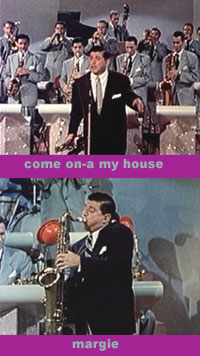 Tony Pastor & His Orchestra provide the instrumentation as Tony shares vocals with Johnny McAfee & Eugenie "Jeanie" Baird. They sing the Irene Higginbotham & Fred Meadows composition That Did It, Marie (1942).
Tony Pastor & His Orchestra provide the instrumentation as Tony shares vocals with Johnny McAfee & Eugenie "Jeanie" Baird. They sing the Irene Higginbotham & Fred Meadows composition That Did It, Marie (1942).
The number had been a hit for the Benny Goodman Orchestra with Peggy Lee a year earlier. As the soundies directors could rarely get the likes of Benny Goodman in their film studios, it was typical to pull together affordable talent to reproduce hits.
It opens with Tony on sax, then there are portraits of the rest of the band as they perform. Then Johnny McAfee steps down from the bandstand, & Eugene "Jeanie" Baird stands from her seat, & they begin their duet on the jazzy number with jiving lyrics:
"I was an ache he couldn't get in the groove/ Till this old band began to move/ Resist fifty, bye bye bye -- that did it, Marie.... Dig that sax, you jumpin' jacks/ Does that eighty-eighter send-ya/ Jump, jump, jump it to the trumpet/ Satch is gonna blow a batch o' riffs..."
Despite a boogie beat & an attempt to be cool, the vocal duet is mediocre & the song not much better even when Peggy Lee did it. A genuinely hep jump-jazz vocalist might've saved it, though none ever did. Tony Pastor's sax solo at least is pretty good.
A pair of dancers jitterbug at the musical instrumentation. When it gets back to the vocal, Tony joins in very briefly, & his rough voice is what would've been better suited to saving the number throughout.
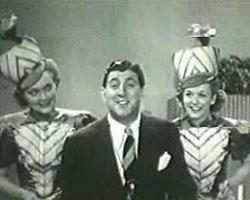 A soundie from Minoco Productions, Doin' the Ratamacu (1942) stars Tony Pastor & His Orchestra, with separate billing for drummer "Johnny (Paradiddle Joe) Morris." The number was written by Johnny Morris & Ed McKinney.
A soundie from Minoco Productions, Doin' the Ratamacu (1942) stars Tony Pastor & His Orchestra, with separate billing for drummer "Johnny (Paradiddle Joe) Morris." The number was written by Johnny Morris & Ed McKinney.
It opens with Tony on his sax in front of the band, & very quickly a close-up of Johnny Morris, & a few other portraits of individual musicians before Tony begins singing:
"Come & hear what the drummer has found/ He's got a beat that's been kicked all around/ It's nothin' new but he'll send you to town/ Donin' the ratta-ma-cue."
The novelty song gets speedier & more fun. Six showgirls flanking Tony are in drummer-girl outfits & tiny drums. Johnny Morris does one, two, & three ratamacues, arranged very similar to the progressive three solos as in the hit song "Paradiddle Joe" to which "Doin' the Ratamacu" was a sequel.
"Ratamacu" & "Paradiddle" & Johnny Morris became widely known as "Paradiddle Joe" for having "starred" in these numbers which Tony sang. Nevertheless, when Johnny left the orchestra & Henry Riggs replaced him, Henry did the novelty numbers, becoming the new Paradiddle Joe.
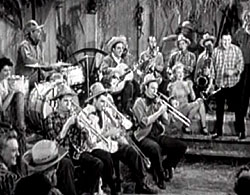 Tony Pastor & His Orchestra star with some cute girls, a cow, & a calf, in Oh, Marie (1941), a Panoram soundie. The setting is the interior of a barn, straw all around, tools hung on the wall. Tony Pastor & His Orchestra star with some cute girls, a cow, & a calf, in Oh, Marie (1941), a Panoram soundie. The setting is the interior of a barn, straw all around, tools hung on the wall.
The orchestra is wearing hick outfits & hats, giving the number the look of the "corn" soundies reliant on stereotypical hillbillies. But this song in no way fits the corn content.
Tony obviously refused to wear one of the foolish hats. He stands conducting his guys with his sax in hand, wearing a plaid shirt instead of his usual suit, but that's his only concession to cliche "corn" soundie staging.
A couple is sitting up in the loft with their legs dangling. The stage is quite crowded, not even counting the cows. The instrumental opening is perfectly decent though in no way fitting the image we are given.
Tony plays a wailing sax solo while a hillbilly & some milkmaids hop about in the background. He then hands off the sax to one of the nearby girls. She holds it in her lap while Tony wails even better with his tough vocal:
"Oh, Marie. My Marie/ Hear my song, you belong, just to me." The lyrics that follow are unique to Tony's version. There's a major horn solo during the instrumental break, then the vocal close by Tony.
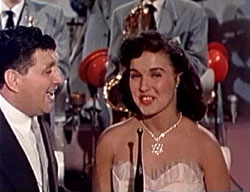 The Snader Telescriptions were filmed in black & white, but someone, Turner Broadcasting probably, colorized a shitload of them, including Your Red Wagon (1950) with Tony Pastore & His Orchestra.
The Snader Telescriptions were filmed in black & white, but someone, Turner Broadcasting probably, colorized a shitload of them, including Your Red Wagon (1950) with Tony Pastore & His Orchestra.
Tony was a top sax man shown wearing black in the opening scene, sharing a sax duet with a bandmember. It's his sideman playing the lead though, so that Tony can sing to the jazzy beat:
"If you wanna go crazy & act the clown/ Be the laughingstock all over town/ That's your red wagon/ That's your red wagon/ That's your red waggon so just keep draggin' your red red wagon around..."
Lyrics are by Don Raye, music by Gene de Paul & Richard M. Jones. Raye wrote lyrically hip tones like "Scrub Me Mama With a Boogie Beat" & "Beat Me Daddy Eight to the Bar."
With Gene de Paul he also wrote hipster lyrics for "Cow Cow Boogie" & "Solid Potato Salad," among much else that captures the era so perfectly; & de Paul worked also with Sammy Cahn & Johnny Mercer.
Your Red Wagon quite a delightful & amusing number, with some call & response from the band. After Tony sings the second verse, Dolores Martel squeezes up close to the microphone & takes over the vocal for a few lines, then it's back to Tony. Very nice.
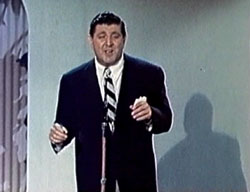 Likewise colorized is Margie (1951) with the shared stage arrangement of all the Snader telescriptions. For the standard, the band is in full play, quite nicely jazzing up the tune, & Tony bouncing up front joins in with his sax.
Likewise colorized is Margie (1951) with the shared stage arrangement of all the Snader telescriptions. For the standard, the band is in full play, quite nicely jazzing up the tune, & Tony bouncing up front joins in with his sax.
A good arrangement pulls us into the song, then Tony strolls away from the band to a microphone with the band no lonver visible. Tony dominates the screen to sing:
"Margie! I'm always thinking of you, Margie/ I'll tell the world I love ya/ don't forget your promise to me/ I bought a home & ring & beedly bobba boody-yoo, Margie..."
The instrumental break shows us more of the band, but only for fifteen seconds before the vocal wrap-up.
He gives a melodiously rough-hewn wonderfully entertaining interpretation of the Roaring Twenties jazz classic. It was written by J. Russell Robinson, Benny Davis & Con Conrad, all names to reckon with though when "Margie" was a new song they were just getting started as composers.
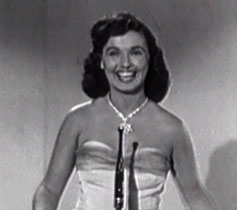 The copy I viewed of Come On-a My House (1951) wasn't colorized so we get the original look of the Snader telescriptions. This novelty number is given a great instrumental opening with horn fanfare from Stubby Pastor upraising it as jazz.
The copy I viewed of Come On-a My House (1951) wasn't colorized so we get the original look of the Snader telescriptions. This novelty number is given a great instrumental opening with horn fanfare from Stubby Pastor upraising it as jazz.
Then Dolores Martel enters through a curtained archway. This archway, by the way, is seen in many telescriptions for many singers & bands. Dolores stands away from the band at the microphone singing:
"Come on to my house, my house/ I'm going to give you candy/ Come on to my house, my house, I'm going to give you apple & plum & apricots too..."
Her insistance on proper diction for "Come on to my house" blows most of the song's humor & Dolores is treating it as too much of a serious song. Rosemary Clooney -- even though somewhat annoyed that only her novelty records were hits & her serious jazz singing not often in the charts -- nevertheless gave this number her whole heart & camped it up rather joyfully.
Dolores can't compare to Rosemary. Really her voice is too generic & whoever attended Tony's concerts during this period must've wanted her to scoot out of the way so they could hear Tony sing stuff himself.
There's a big horn solo, followed by a baritone sax solo, then back to Dolores's vocal close. She's cute with a nice smile but she hasn't a clue how to treat this odd lyric.
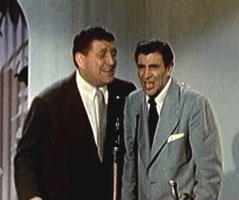 Colorized again, Life is So Peculiar (1951) offers up the amusing Stubby Pastor alongside Tony Pastor at the microphone. Colorized again, Life is So Peculiar (1951) offers up the amusing Stubby Pastor alongside Tony Pastor at the microphone.
It opens with a full portrait of the band, but then Tony leads Stubby to the microphone stage left (our right) where Tony sings:
"Yes life, is so peculiar/ You get so wet in the rain." Stubby intrudes with the query, "Why don't you take an umbrella?" Tony replies: "You get so warm in the sunshine." Stubby: "It's hot inside."
They continue to trade off on comedic lyrics such as " Yes, life is so peculiar/ A fork belongs with the knife/ Corn beef is lost without cabbage/ A husband should have a wife..."
Stubby is holding his horn throughout. At the instrumental break Tony returns to the front of the band, & Stubby gets full screen attention for a big solo. Then Tony comes back to the mic alongside Stubby for more comic lyrics.
Amusing as this is, it's far from the best of Tony's snaders, & just about everyone else who covered this number did it better.
Written by Johnny Burke & Jimmy Van Heusen during the Roaring Twenties, it remained popular with singers through the 1950s, providing an opportunity for comedy & jump-jazz in one big bite. It was in the repertoir of Louis Armstrong & Louis Jordan (who recorded it as a duet), Martha Davis, Frank Sinatra, & many
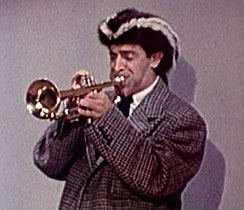 Brother Bill (1951) is a nutty little song that had its popularity, gods know why, as it's just the silliest thing. But it provided the theatrically inclined Tony with opportunities for whimsical enthusiasm.
Brother Bill (1951) is a nutty little song that had its popularity, gods know why, as it's just the silliest thing. But it provided the theatrically inclined Tony with opportunities for whimsical enthusiasm.
Stubby Pastor is shown first, in a skunkskin cap & hunting rifle. Out strolls Tony Pastor in deerstalker hat, hunting jacket, & rifle. Tony begins:
"Me & brother bill were hunting/ Up in the woods of Eastern Maine/ The reason why we went up there/ We thought we could catch some game..."
So far this one ain't much. Stubby just stands nearby being the Bill character but doing nothing. There's an instrumental break for the whole band but they can't do all that much with the tune either.
Stubby gets the camera & he's put aside the rifle in favor of his horn. Still in the skunkskin cap he tries to swing but nothing can save this number. He puts down the horn, picks up the rifle, then vamps a bit behind Tony as he wraps up the silly lyric.
Frankly, I would've thought if anyone could make anything of this song about a hunting expedition gone awry, it would've been Tony Pastor. But this is by far his worst telescription. There's also a soundie Brother Bill (1945) by the harmony group the Jubilaires, & they couldn't make much more than comedy of it either.
copyright © by Paghat the Ratgirl
|
